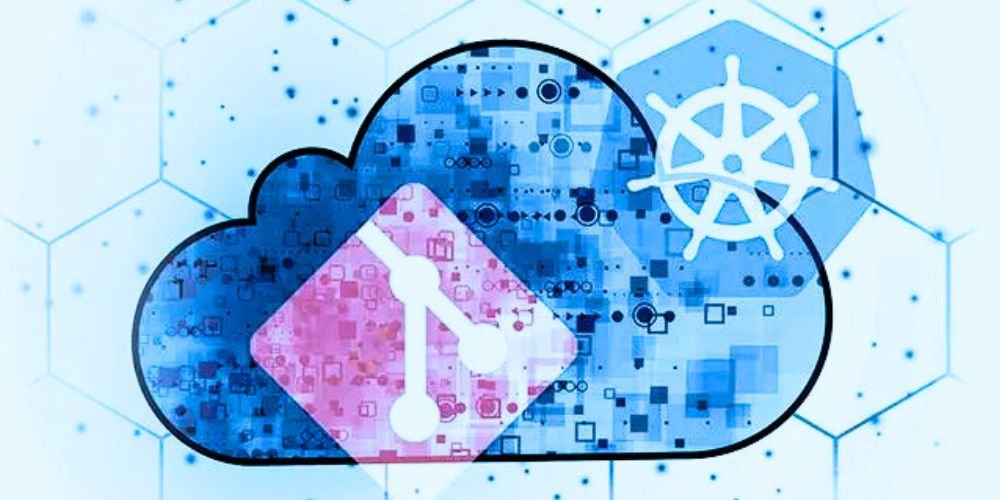Cloud GitOps represents a transformative approach to managing cloud infrastructure and applications. It leverages the principles of version control and Git repositories to automate deployment, configuration, and monitoring processes. In this article, we explore the significance, principles, and benefits of Cloud GitOps, explaining how it streamlines DevOps practices and enhances scalability in cloud computing environments.
Understanding Cloud GitOps
Cloud GitOps is an operational model that combines Git version control and Infrastructure as code (IaC) principles to manage cloud infrastructure and application deployments. It revolves around using Git repositories as a single source of truth for defining and maintaining infrastructure configurations, application code, and deployment pipelines. By adopting GitOps practices, organizations can automate and standardize deployment workflows, improve collaboration between development and operations teams, and achieve greater agility and scalability in the cloud.
Infrastructure as Code (IaC)
At the core of Cloud GitOps is Infrastructure as Code (IaC), which involves defining infrastructure configurations and provisioning resources using Code rather than manual processes. Infrastructure definitions, such as cloud resources, networking configurations, and security policies, are stored in Git repositories as code files. It enables teams to version, track changes, and collaborate on infrastructure configurations using familiar Git workflows, ensuring consistency and repeatability across environments.
GitOps Workflows
Cloud GitOps employs GitOps workflows to automate deployment, configuration, and management tasks in cloud environments. Git repositories serve as the source of truth for defining desired infrastructure states and application configurations. Changes made to code files trigger automated workflows that apply the changes to cloud environments using declarative configuration management tools such as Terraform, Kubernetes, or AWS CloudFormation. Continuous Integration/Continuous Deployment (CI/CD) pipelines orchestrate the deployment process, integrating code changes, running tests, and promoting changes to production environments based on predefined criteria.
Advantages of Cloud GitOps
Cloud GitOps offers several advantages over traditional deployment and management practices, making it well-suited for modern cloud computing environments. These advantages include automation, repeatability, scalability, and collaboration, enabling organizations to deliver software updates reliably and efficiently while maintaining operational excellence.
Automation
Cloud GitOps automates deployment and management tasks, reducing manual effort, minimizing human error, and improving overall operational efficiency. By codifying infrastructure configurations and deployment processes, organizations can leverage automation tools and scripts to provision and manage cloud resources more efficiently and accurately, enabling faster time-to-market and shorter iteration cycles.
Repeatability
Cloud GitOps ensures repeatability and consistency in deployment processes by treating infrastructure configurations as Code. Version-controlled code files provide a history of changes, enabling teams to roll back to previous states, audit configuration changes, and troubleshoot issues effectively. It ensures that deployments are predictable, reliable, and reproducible across different environments, reducing the risk of configuration drift and deployment failures.
Scalability
Cloud GitOps enables organizations to scale Infrastructure and applications seamlessly to meet changing business requirements and user demands. By leveraging cloud-native technologies and automation tools, organizations can provision, configure, and manage resources dynamically, scaling Infrastructure up or down in response to fluctuating workloads, traffic spikes, or seasonal demand. It ensures optimal performance, resource utilization, and cost-effectiveness in cloud environments.
Collaboration
Cloud GitOps fosters collaboration and alignment between development and operations teams by standardizing deployment workflows and providing a single source of truth for infrastructure configurations. Git repositories serve as a central repository for storing and managing code files, allowing developers, operators, and other stakeholders to collaborate on infrastructure changes, review code, and provide feedback using familiar Git workflows. It promotes transparency, accountability, and shared ownership of deployment processes, driving continuous improvement and innovation.
Implementation Considerations
When implementing Cloud GitOps, organizations should consider several factors to ensure successful adoption and integration with existing workflows and processes. These considerations include tool selection, version control practices, security requirements, and organizational culture and readiness.
Tool Selection
Organizations must select the appropriate tools and technologies for implementing Cloud GitOps, including version control systems, infrastructure as Code (IaC) frameworks, and continuous integration/continuous deployment (CI/CD) pipelines. Popular GitOps tools include GitLab, GitHub, Terraform, Kubernetes, ArgoCD, and Jenkins, each offering different features and capabilities to support GitOps workflows in cloud environments.
Version Control Practices
Organizations must establish version control practices and workflows to manage code files and infrastructure configurations in Git repositories. Best practices include using branching strategies such as GitFlow or trunk-based development, enforcing code reviews and approvals, and implementing branching policies to control access and prevent unauthorized changes. It ensures that changes are tracked, reviewed, and approved before being promoted to production environments.
Security Requirements
Security is a critical consideration in Cloud GitOps, as it involves managing sensitive infrastructure configurations and deployment pipelines. Organizations must implement robust security measures such as access controls, encryption, and authentication mechanisms to protect against unauthorized access, data breaches, and cyber threats. Additionally, organizations should adhere to best practices for secure coding, vulnerability management, and compliance with regulatory requirements such as GDPR and HIPAA.
Organizational Culture and Readiness
Implementing Cloud GitOps requires organizational buy-in, alignment, and readiness across development, operations, and management teams. Organizations must foster collaboration, transparency, and continuous improvement, encouraging teams to embrace change, experiment with new technologies, and learn from failures. Leadership support, training, and communication are essential to drive cultural transformation and successfully adopt GitOps practices.
Conclusion
Cloud GitOps represents a paradigm shift in DevOps practices, enabling organizations to automate deployment, configuration, and management tasks in cloud environments using Git version control and Infrastructure as code principles. Organizations can streamline deployment processes, enhance scalability, and improve collaboration between development and operations teams by treating infrastructure configurations as Code and leveraging automation tools and workflows. As organizations continue to embrace cloud-native technologies and agile practices, Cloud GitOps will play an increasingly important role in driving innovation, competitiveness, and success in the digital era.










